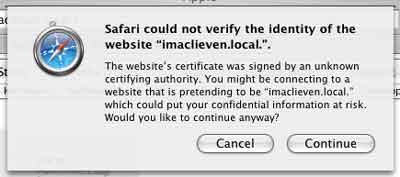 The
The
other members of my family don’t understand what I am trying to do the
last couple of days with all those ethernet-cables, airport-stations,
computer-books and the like. ‘Improving our network’ doesn’t make
much of an impression. To them, our network is fine as it is : from
every computer one has access to the internet and to the only
house-printer and that is what they want. To them, my
computer-phase is just an occupational therapy while recovering
from the flu. Probably they are right but I am obstinate in
experimenting to prove them wrong. Not that there is much hope,
searching the web for possible fun uses of home-networks does not give
that many interesting pages. A noteworthy exception is a series of four
articles by Alan Graham for the macdevcenter
on the homemade dot-mac with OS X-project.
In
the first article Homemade Dot-Mac with OS X he explains how to
set-up a house-network (I will give a detailed account of our
home-network shortly) and firing up your Apache webserver. One nice
feature I learned from this is to connect a computer by ethernet to the
router and via an Airport card to the network (you can force this by
specifying the order of active network ports in the
SystemPreferences/Network/Show Network port configuration-pane :
first Built-in Ethernet and second Airport). This way you
get a faster connection to the internet while still connecting to the
other computers on the network. In the second part he explains how to
get yourself a free domain name even if you have (as we do) a dynamic
IP-address via a service like DynDNS. Indeed it is quite easy to set this up but
so far I failed to reach my new DNS-server from outside the network,
probably because of bad port-mapping of my old isb2lan-router.
This afternoon I just lost two hours trying to fix this (so far :
failed) as I didn’t even know how to talk to my router as I lost the
manual which is no longer online. A few Google-searches further I
learned that i just had to type http://192.168.0.1 to get at the set-up pages
(there is even a hidden page) but you shouldnt try these links
unless you are connected to one of these routers. Maybe I will need
another look at this review.
In the second
article, Homemade Dot-Mac with OS X, Part 2 he discusses in
length setting up a firewall with BrickHouse (shareware costing $25) compared to the
built-in firewall-pane in SystemPreferences/Sharing convincing me
to stay with the built-in option. Further he explains what tools one can
use to set up a homepage (stressing the iPhoto-option).Finally, and this
is the most interesting part (though a bit obscure), he hints at the
possibility of setting up your own iDisk facility either using
FTP (insecure) or WebDAV.
The third article in the
series is Homemade Dot Mac: Home Web Radio in which he
claims that one can turn the standard OS X-Apache server into an iTunes
streaming server. He uses for this purpose the QuickTime Streaming Sever which you can get for
free from the Apple site but which I think works only when you have an
X-server. It seems that all nice features require an X-server so
maybe I should consider buying one…
The (so far)
final article is Six Great Tips for Homemade Dot Mac Servers is
really interesting and I will come back to most op these possibilities
when (if) I get them to work. The for me most promising options are :
the central file server (which he synchronizes using the
shareware-product ExecutiveSync ($15 for an academic license) but
I’m experimenting also a bit with the freeware Lacie-program Silverkeeper which seems to be doing roughly the
same things. The iTunes central-hack is next on my ToDo-list as
is (at a later stage) the WebDav and the Rendezvous-idea. So it seems
I’ll prolong my occupational therapy a while…

 A
A